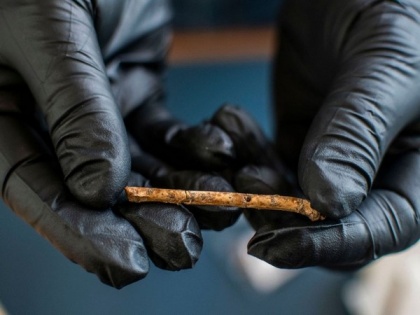12,000-year-old flutes imitated bird calls, say archaeologists
By ANI | Published: June 11, 2023 10:06 PM2023-06-11T22:06:23+5:302023-06-11T22:10:09+5:30
Tel Aviv [Israel], June 11 (ANI/TPS): The world's oldest flute, 12,000 years old, wasn't created by Neanderthals for entertainment ...

12,000-year-old flutes imitated bird calls, say archaeologists
Tel Aviv [Israel], June 11 (ANI/TPS): The world's oldest flute, 12,000 years old, wasn't created by Neanderthals for entertainment and amusement.
The remains of several flutes including one still intact discovered during an excavation in the Hula Valley in northern Israel date back to the Natufian period. Made from the wing bones of waterfowl, archaeologists believe they imitated the calls of predatory birds.
The excavation of the Eynan/Ain Mallaha site, first initiated by a French mission in 1955 and later continued by a joint team from the Centre de Recherche Francais a Jerusalem (CRJF) and the Israel Antiquities Authority (IAA), also uncovered circular structures and evidence of hunter-gatherer settlements, containing bones of various animal species, including birds.
Dr Laurent Davin, a postdoctoral fellow at the Hebrew University of Jerusalem and the CRJF, and Dr Jose-Miguel Tejero from the University of Vienna and the University of Barcelona spearheaded the material culture study and analysis of bird bones recovered at Eynan/Ain Mallaha. Most notably, they observed marks on seven miniature wing bones from Eurasian coots and Eurasian teals. Upon closer examination, they discovered tiny holes bored into the hollow bones.
"One of the flutes was discovered intact, making it the only one in the world to be preserved in this state," said Dr Laurent Davin of the Israel Antiquities Authority.
Their findings were published on Friday in the peer-reviewed Nature Scientific Report.
To understand the purpose of these objects, the researchers collaborated with experts at the Centre Nationale de Recherche Scientifique (CNRS), a French research organization, to create replicas of the flutes. Through experiments conducted with the replicas, they determined that the instruments produced distinct sounds, leading them to conclude that they were indeed flutes.
The sounds made, when compared to the calls of various bird species found at Eynan/Ayn Malaha, closely resembled those of birds of prey, such as the Eurasian Sparrowhawk and the Common Kestrel.
The Hula Valley is a key stopover point for millions of birds of hundreds of species migrating between Africa and Europe. Today, the Hula Nature Reserve is a world-renowned birdwatching site.
One theory proposed by the researchers suggests that people equipped with these flutes would position themselves near waterfowl. By imitating the calls of birds of prey using the flutes, they would attract the attention of the waterfowl, causing them to take flight in different directions, making them easier to catch. This tactic may have also led to the capture of the birds of prey themselves, as their claws could be used to pierce bones and create new flutes.
"The replicas created by the researchers produced the same sounds that the ancient hunter-gatherers may have made 12,000 years ago," Davin said.
Additionally, the sounds produced by the flutes may have served various social, cultural, and symbolic functions.
The Antiquities Authority's Dr Hamoudi Khalaily said, "If the flutes were indeed used for hunting, this would be the earliest evidence of sound being employed in such a manner. In most sites from the same period as Eynan, these instruments deteriorated and disappeared. Their discovery through careful excavation and sieving of the finds using water provides significant new information on hunting methods and complements the range of prehistoric tools associated with the transition from agriculture to animal and plant cultivation in the southern Levant." (ANI/TPS)
Disclaimer: This post has been auto-published from an agency feed without any modifications to the text and has not been reviewed by an editor
Open in app